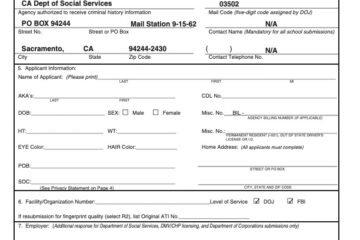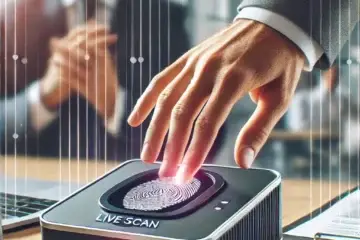Live scan fingerprinting is a modern, digital method of capturing fingerprints for background checks, employment, licensing, and other legal purposes. Unlike traditional ink fingerprinting, live scan technology scans fingerprints electronically and submits them directly to government agencies. This process is faster, more accurate, and less messy than ink-based methods.
If you are applying for a job, professional license, visa, adoption, or FBI background check, you may need to complete a live scan fingerprinting session. Knowing what to expect can help you prepare for the process and avoid unnecessary delays.
What Is Live Scan Fingerprinting?
Live scan fingerprinting is an electronic fingerprinting process that captures fingerprints using a digital scanner instead of ink. The fingerprints are transmitted electronically to relevant agencies such as the FBI, state law enforcement, or other government departments for background checks.
This method reduces errors caused by smudging or poor-quality ink prints and speeds up the fingerprint verification process. Many employers, licensing agencies, and law enforcement organizations prefer live scan technology because it ensures greater accuracy and efficiency.
Who Needs Live Scan Fingerprinting?
Live scan fingerprinting is required for various purposes, including:
- Employment background checks for government jobs, education, healthcare, and financial institutions.
- Professional licenses for real estate, nursing, law enforcement, and other regulated industries.
- FBI background checks for visas, immigration, and international travel.
- Adoption screenings to verify criminal history before adoption approval.
- Volunteer work in schools, youth organizations, and religious institutions.
Many states require live scan fingerprinting for licensing and certification processes to ensure public safety and prevent fraud.
How to Prepare for Live Scan Fingerprinting
Before scheduling a live scan fingerprinting appointment, check with the organization or agency requesting your fingerprints to confirm their requirements. You will need specific forms, identification, and payment before your session.
The most important document is the live scan request form, which contains information about the applicant, agency requesting the fingerprints, and submission details. If you do not have this form, the fingerprinting facility may not be able to process your request.
A valid government-issued photo ID is required for identity verification. Accepted forms of ID include a driver’s license, passport, or state ID card. Some facilities may also accept military IDs or other government-issued documents.
What Happens During a Live Scan Fingerprinting Session?
When you arrive at the live scan fingerprinting facility, you will be asked to provide your live scan request form and identification. The technician will verify your documents and ensure you are eligible for fingerprinting.
The technician will then guide you to a live scan fingerprinting machine, which consists of a digital scanner that captures high-resolution images of your fingerprints. Instead of rolling your fingers in ink, each finger is scanned electronically.
The technician will carefully roll each finger over the scanner to capture all necessary fingerprint details. The scanner ensures clear and accurate prints to minimize errors or rejections.
Once all fingerprints are collected, the system automatically transmits them to the appropriate agency. Some facilities provide a printed copy or electronic receipt confirming submission.
How Long Does the Live Scan Fingerprinting Process Take?
The live scan fingerprinting process is quick and efficient, typically taking 10 to 15 minutes from start to finish. If the fingerprinting center is busy, waiting times may be longer. Scheduling an appointment in advance can help reduce wait times.
Once fingerprints are submitted, processing times depend on the receiving agency. Most background check results are processed within 24 to 72 hours, but some government agencies may take longer due to higher volumes of requests.
How Much Does Live Scan Fingerprinting Cost?
The cost of live scan fingerprinting varies by location, service provider, and submission requirements. In general, pricing includes two components:
- Rolling Fee – This is the fee charged by the fingerprinting facility for scanning and submitting fingerprints. The cost usually ranges from $20 to $50, depending on the location.
- Background Check Fee—Government agencies charge a fee to process and review fingerprint submissions. Fees vary depending on whether fingerprints are being checked against state databases, FBI records, or both.
Some employers or organizations cover live scan fingerprinting costs, while others require applicants to pay out of pocket.
What Happens If Fingerprints Are Rejected?
Although live scan fingerprinting is more accurate than traditional ink fingerprinting, fingerprint rejection can still occur due to low-quality prints, scars, or medical conditions that affect fingerprint clarity.
If your fingerprints are rejected, you may receive a notice from the requesting agency asking you to resubmit them. Many live scan centers allow one free re-submission if fingerprints are rejected due to poor quality.
To reduce the chances of rejection, ensure your hands are clean and dry before fingerprinting. Avoid lotions or creams that can make fingertips too smooth for the scanner to capture details.
Live Scan vs. Ink Fingerprinting: What’s the Difference?
Live scan fingerprinting is faster, cleaner, and more reliable than ink fingerprinting. Traditional ink fingerprinting requires rolling fingers in ink and pressing them onto paper, which can lead to smudges, unclear prints, and errors.
In contrast, live scan fingerprinting captures fingerprints electronically, allowing immediate transmission to law enforcement or government agencies. Live scan eliminates the need for mailing physical fingerprint cards, reducing processing time.
Some agencies still require traditional ink fingerprints, especially for international use or federal employment applications. Always confirm with the requesting agency whether live scan or ink fingerprinting is required.
How to Find a Live Scan Fingerprinting Location
Live scan fingerprinting services are available at:
- Police departments that offer fingerprinting for background checks.
- Private fingerprinting agencies that specialize in live scan services.
- UPS stores and notary offices that provide fingerprinting as an additional service.
- State-approved vendors listed on government websites.
Many fingerprinting locations require appointments, while others accept walk-ins. Checking ahead of time ensures availability and faster processing.
Final Steps After Live Scan Fingerprinting
After completing the live scan process, it is important to follow up with the requesting agency to confirm that your fingerprints have been received. If results are delayed, contacting the agency can help track the status of your background check.
If your fingerprints were submitted as part of a visa or licensing application, make sure all additional documentation is submitted before the deadline. Keeping a copy of the receipt or transaction number can help with tracking if there are any issues.
Conclusion
Live scan fingerprinting is a fast and efficient way to submit fingerprints for background checks, employment, licensing, and legal purposes. It eliminates the mess and errors of traditional ink fingerprinting while providing quick submission and processing.
Understanding what to expect, how to prepare, and where to go ensures a smooth experience. By following proper guidelines and confirming requirements with the requesting agency, you can complete the live scan fingerprinting process without complications or delays.



0 Comments